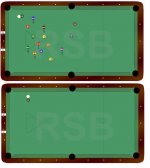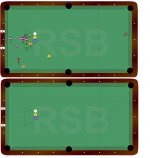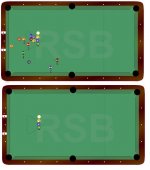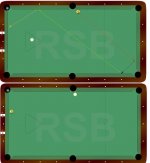Okay, after numerous requests I am posting 4 of the safeties that Grady Mathews showed me during a recent lesson (with Grady’s permission). Remember that these safeties were probably only 5 minutes worth of an 8 hour lesson – Grady moves at a brisk pace. All of you wanna-be-pool-hustlers should take a lesson from Grady – or at the very least buy one or more of his tapes – do yourself a favor, and support someone who has devoted his life to the game, and has contributed more to the game than any of us (shameless and unpaid for advertisement).
All I really want to know is how many of you know these safeties? Look at all 4, and let me know (either on this thread or in a PM) which ones you already know and use. Thanks.
Here is safety #1, which, when Grady showed it to me made me almost physically ill (since it was a position that lost an extremely crucial mid- season match for me during the last straight pool season). I was behind 95-94 (playing to 100) against the best player in the league, when he broke the balls, missed, and left a wide open table as below. Unfortunately for me, the cue ball was frozen to the 8 ball and I had NO shot, and NO easy safety . The balls were not exactly as below – the crucial part is knowing what to do when your cue ball is frozen to another ball near the rail. This safety is applicable to many pool games besides straight pool.
Just aim towards the closest long rail to just barely skim the 8 ball, use a very soft stroke. The 8 ball will just move slightly, and the cue ball will go to the long rail, and back to the 8 ball, coming to rest right against the 8-ball (as in the second diagram below). Experiment with it, you usually need a little left or right English depending on the exact orientation of the cue ball and 8 ball
All I really want to know is how many of you know these safeties? Look at all 4, and let me know (either on this thread or in a PM) which ones you already know and use. Thanks.
Here is safety #1, which, when Grady showed it to me made me almost physically ill (since it was a position that lost an extremely crucial mid- season match for me during the last straight pool season). I was behind 95-94 (playing to 100) against the best player in the league, when he broke the balls, missed, and left a wide open table as below. Unfortunately for me, the cue ball was frozen to the 8 ball and I had NO shot, and NO easy safety . The balls were not exactly as below – the crucial part is knowing what to do when your cue ball is frozen to another ball near the rail. This safety is applicable to many pool games besides straight pool.
Just aim towards the closest long rail to just barely skim the 8 ball, use a very soft stroke. The 8 ball will just move slightly, and the cue ball will go to the long rail, and back to the 8 ball, coming to rest right against the 8-ball (as in the second diagram below). Experiment with it, you usually need a little left or right English depending on the exact orientation of the cue ball and 8 ball
Attachments
Last edited:




